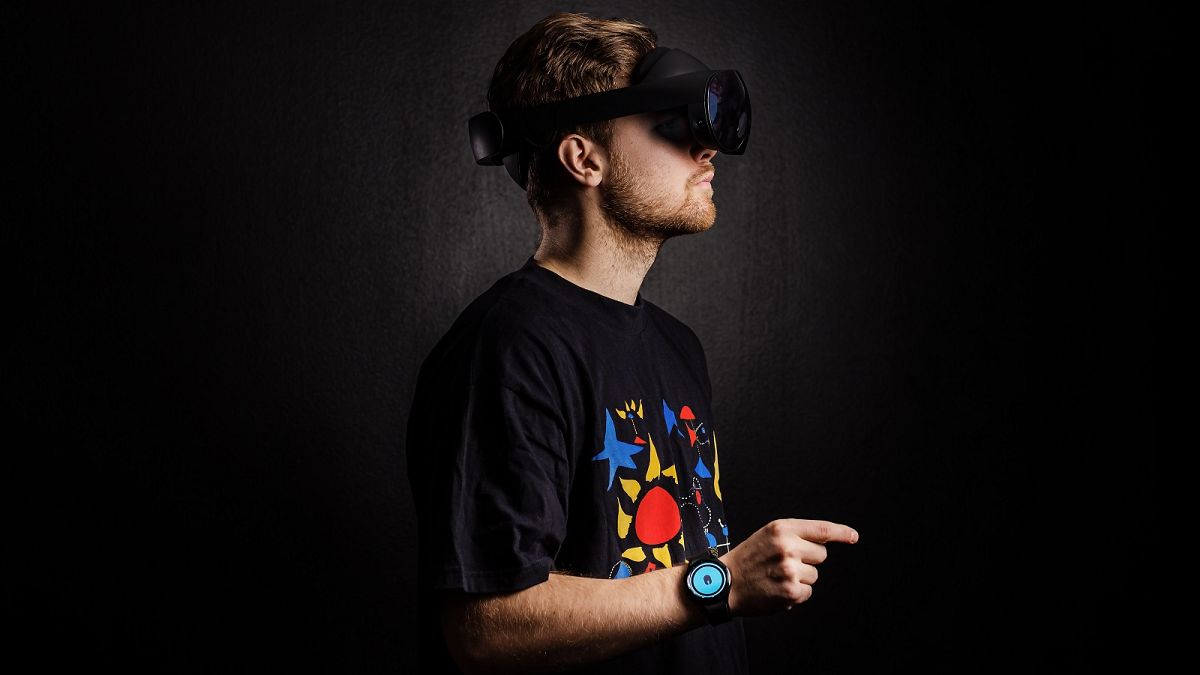Using gesture technology, Doublepoint’s WowMouse app allows your wearable to control your devices, AR headsets, and even house lights at a finger tap.
In a single pincer motion, Jamin Hu switches off a lamp with the ease and agility of a Jedi knight.
The co-founder and chief technology officer (CTO) of the Finnish start-up Doublepoint is demonstrating the effectiveness of its Bluetooth-enabled, touch-gesture technology at Mobile World Congress (MWC) in Barcelona.
Through the smartwatch strapped to his wrist, Hu can morph into a human computer mouse, giving him the power to trip switches around the house or animate his devices at a distance.
“If I just switch it on here, you’ll see that it responds to my finger taps, and that’s basically what causes a click to happen,” says Hu.
“I can go to the home screen and I can open the camera app. I can take a few photos of myself,” he says, setting the camera on his iPad snapping selfies with a few taps of his thumb and index finger.
“And, I can also, for example, go to Spotify. I can listen to my favourite Taylor Swift”.
This time, he’s able to select the singer’s hit ‘Cruel Summer’ from his pocket rather than pointing and pulling the trigger.
Since launching at the Consumer Electronics Show (CES) in Las Vegas in January, Doublepoint’s free WowMouse touch control app boasts more than 30,000 Android users with Samsung Galaxy 4, 5, and 6 smartwatches in just over a month.
Seeing a 20 per cent increase in weekly downloads already, the company expects the figure to rise substantially after officially announcing its integration with Google Pixel 2 smartwatches at MWC this week.
The initial success of the app is even more remarkable given its origins as a student project.
‘Touchscreen of the 3D world’
“Jamin is a classically trained pianist, and he has this tendency to subconsciously type his thoughts in mid-air, essentially,” CEO and co-founder of Doublepoint Ohto Pentikäinen told Euronews Next.
“And my colleague wanted to make a wristband which could automatically log these messages that he was writing subconsciously”.
Exploring this further, Hu built a prototype with scotch tape, cardboard, and sensors.7
While recognising his own needs were niche, he, along with childhood friend Pentikäinen, saw a gap in the market with the idea of an input device for augmented reality (AR) headsets and glasses.
“People already then saw that in smart 2D environments, touchscreen is absolutely essential. But for 3D environments, we started looking into gesture,” Pentikäinen said.
Beyond the gimmicks of the demo, Doublepoint’s app has other real-world applications when used alongside AR/VR headsets. This in itself presents interesting possible uses in industrial and professional as well as domestic settings.
Initially, the first prototype was for use with AR, Pentikäinen explains, “but actually why we ended up working with smartwatches is because we found that you cannot really do a lot of the most important stuff with what’s already out there in the market”.
Now, Doublepoint licenses its software to allow others in the industry to integrate it into their platforms, with users able to download the WowMouse app for free.
“At the moment, we’re the only company in the industry that provides a software solution for this. Which is of course, very interesting to a lot of companies”.
Touch-gesture technology is being increasingly embraced as the concept of spatial computing – blending reality with experiences in 3D environments – as evidenced by the recent launch of Apple’s Vision Pro earlier this month.
“We think this [WowMouse] is the touchscreen of the three-dimensional world,” Pentikäinen told Euronews Next.
“Whenever we go into AR, VR, into IoT, into automobiles becoming more of a commodity rather than just something that you just kind of take from A to B. When these things become more part of our environment. When we want to interact with something virtual or something real; not through 2D, but in 3D – we think gestures are going to be the way”.

Jessica Irvine is a tech enthusiast specializing in gadgets. From smart home devices to cutting-edge electronics, Jessica explores the world of consumer tech, offering readers comprehensive reviews, hands-on experiences, and expert insights into the coolest and most innovative gadgets on the market.


